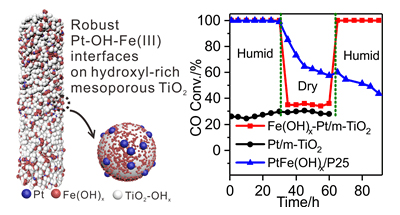摘要/Abstract

在负载型金属催化剂中,载体不仅可以提高金属分散度,同时还创造了独特的金属-载体界面.在特定的反应中,这些界面位点被认为是主要活性位点.对于这些体系,其催化性能的关键在于能否构建丰富且稳定的界面活性位点.本研究中,以乙二醇-钛前驱体水解得到的超高比表面积介孔TiO2作为载体(m-TiO2,490 m2/g),通过紫外光照沉积得到m-TiO2负载的高度分散的Pt纳米颗粒(1.9 wt% Pt,2.7 nm).相较而言,在商业P25 TiO2上负载量仅有0.2 wt%,而Pt的尺寸却达6.7 nm.通过简单的沉积沉淀法可以在Pt/m-TiO2和Pt/P25进一步构筑超高活性和稳定性的Pt-OH-Fe(Ⅲ)界面,所得到的Fe(OH)x-Pt/m-TiO2在催化低温CO氧化反应中表现出超高活性和稳定性,而Fe(OH)x-Pt/P25却会在测试过程中发生不可逆的失活.研究发现,相较于P25表面密度较小且对湿气不敏感的羟基物种,m-TiO2的高比表面积、介孔结构以及表面具有丰富(且对湿气敏感)的羟基(10.6 mmol/g,12.5 nm-2),可以确保Pt-OH-Fe(Ⅲ)界面在CO氧化的放热反应中不会因为脱水发生不可逆的失活.
关键词: 介孔TiO2, CO氧化, 表面羟基, 催化界面, 催化氧化
In supported heterogeneous catalysis, supports are used not only to enhance the metal dispersion and catalytic stability of metal catalysts, but also to create metal-support interfaces for improving their catalytic performance in specific reactions. For the interfaces controlled catalytic system, the construction of abundant and stable interfaces is very important. For this purpose, the physical and chemical properties of the support especially their surface species play the central role. In this work, mesoporous TiO2 (m-TiO2) with ultrahigh surface area (490 m2/g) was prepared by the hydrolysis of titanium glycolate complex. Highly dispersed metallic Pt nanoparticles (ca. 2.7 nm) with 1.9 wt% Pt loading were then supported onto the mesoporous TiO2 by a UV deposition method at room temperature. While, for commercial P25 as the support, following the same protocol, ca. 6.7 nm Pt nanoparticles with only 0.2 wt% Pt loading were obtained. The Pt-OH-Fe(Ⅲ) interfaces were then successfully constructed by a facile deposition-precipitation procedure on both Pt/m-TiO2 and Pt/P25. The as-prepared catalysts exhibited high activity for low temperature CO oxidation, 100% conversion was achieved at 313 K for the m-TiO2 supported Fe(OH)x-Pt catalyst, Fe(OH)x-Pt/m-TiO2, under 50% humidity condition with weight hourly space velocity (WHSV), ca. 400 L/gPt/h (1 vol% CO). In comparison, under the same conditions the P25 supported Fe(OH)x-Pt catalyst, Fe(OH)x-Pt/P25, reached 100% conversion at 323 K in the first light-off test but gradually deactivated in further test cycles. The performance of Pt-OH-Fe(Ⅲ) interfaces on m-TiO2 were highly relied on the humidity of the feed gas. Despite the low activity under dry feed gas condition, Pt-OH-Fe(Ⅲ) interfaces exhibited robust catalytic performance during the long-time and humid/dry feed gas switch test, and the catalytic activity immediately recovered upon introduction of humid feed gas. It was revealed that, m-TiO2 possessed rich surface hy-droxyl groups (10.6 mmol/g, 12.5 nm-2) which were very sensitive to the humidity of feed gas. Through protons transfer on the surface, the rich and sensitive hydroxyl groups on m-TiO2 maintained the Pt-OH-Fe(Ⅲ) interfaces from irreversible de-hydration. By contrast, for the hydroxyl groups on P25, a much lower density and smaller change were detected under both the dry and humid conditions, which resulted in irreversible deconstruction of the Pt-OH-Fe(Ⅲ) interfaces during the exothermic CO oxidation.
Key words: mesoporous TiO2, CO oxidation, surface hydroxyl group, catalytic interface, catalytic oxidation
PDF全文下载地址:
点我下载PDF
